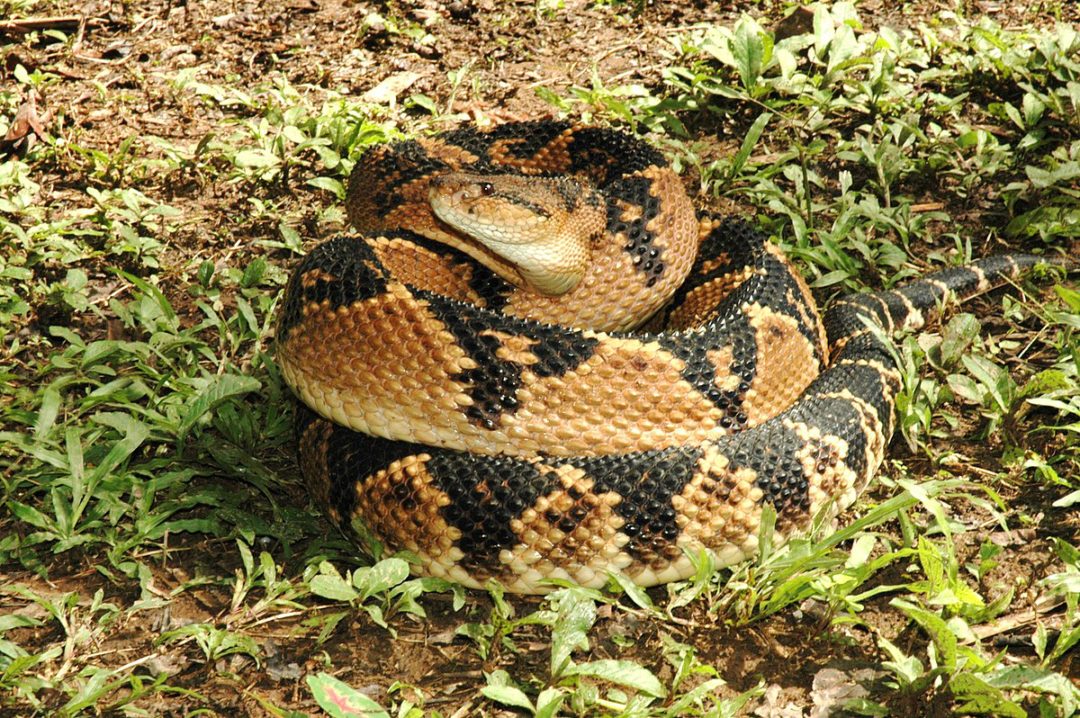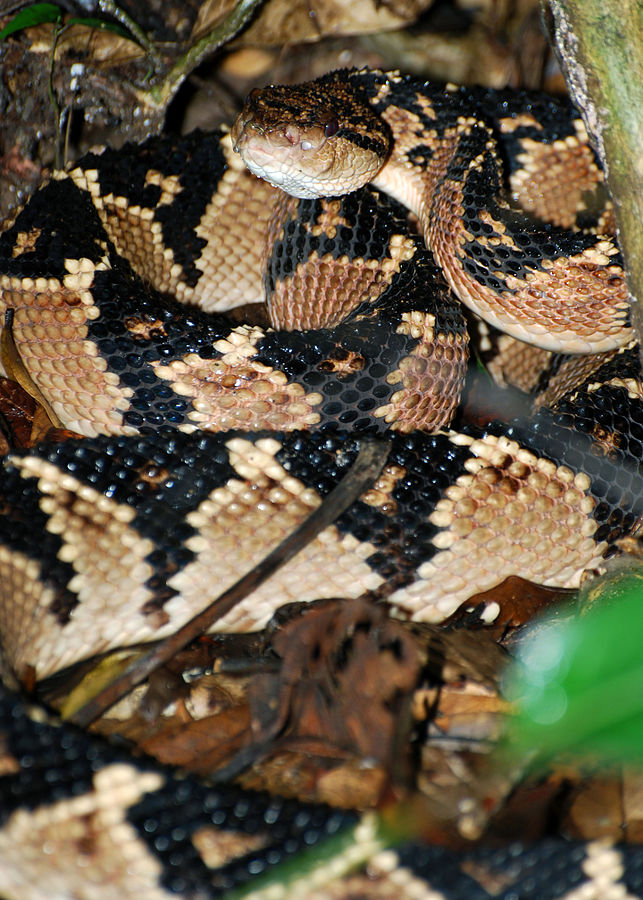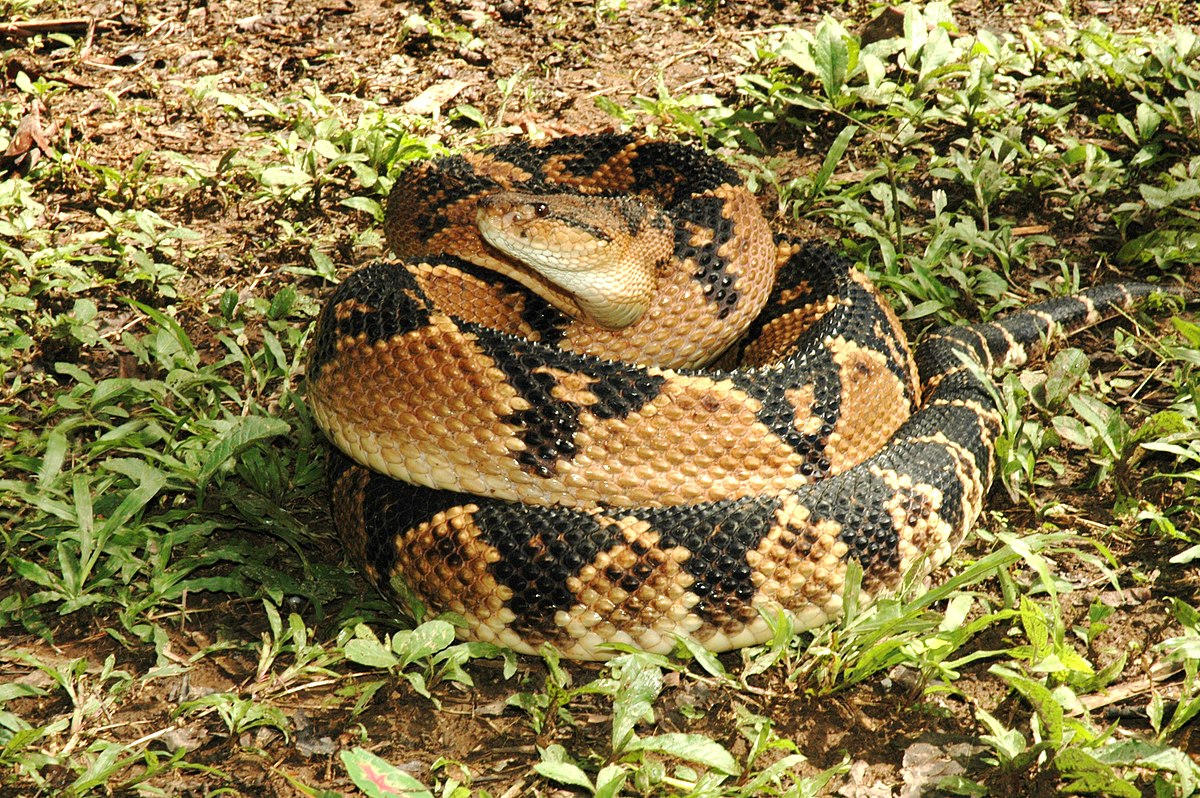BUSHMASTER! When you hear the name bushmaster in Guyana, it is often followed by feelings of fear and awe. The bushmaster is a very large snake, with specimens often exceeding 6, 5 ft. (2 m) in length. But they can grow to be over 12 ft. (3.5 m) making them the longest venomous snake found in the Americas. They exceed even the American eastern diamondback rattlesnake making them the largest pit viper in the world. They are also considered the second longest venomous snake in the world after the king cobra (Ophiophagus hannah).

By Christopher Murray – en:Image:Lachesis muta muta.jpg, Public Domain, https://commons.wikimedia.org/w/index.php?curid=1120263
Species of the Bushmaster
- L. acrochorda
- L. melanocephala (Black-headed bushmaster)
- L. stenophrys (Central American bushmaster)
- L. muta (South American bushmaster)
The species found in Guyana is the South American bushmaster – L. muta.
Subspecies for Lachesis Muta:
- Lachesis muta muta (South American bushmaster) – Found in Guyana.
- Lachesis muta rhombeata (Atlantic Forest bushmaster) – Found in Brazil.
Scientific Classification of the Bushmaster
South American Bushmaster – Lachesis Muta [Scientific name]

By ggallice (Geoff Gallice) – https://www.flickr.com/photos/dejeuxx/5215887699/, CC BY 2.0, https://commons.wikimedia.org/w/index.php?curid=13267515
- Kingdom: Animalia
- Phylum: Chordata
- Class: Reptilia
- Order: Squamata
- Suborder: Serpentes
- Family: Viperidae
- Genus: Lachesis
- Species: L. muta
Tip: The largest recorded bushmaster was almost 3.65m (12 feet) long, making this the largest of all vipers and the longest venomous snake in the western hemisphere.
Features of the Bushmaster
- Color Pattern: The color pattern consists of a yellowish, reddish or grey-brown ground color, overlaid with a series of dark brown or black dorsal blotches that form lateral inverted triangles of the same color. The lateral pattern may be precisely or indistinctly defined, normally pale at the center.
- Head: The head is broad and distinct from the narrow neck. The snout is broadly rounded and there is no canthus. There is a pair of small internasals, separated by small scales. The supraoculars are narrow and other parts of the crown are covered with very small scales. Laterally, the second supralabial forms the anterior border of the loreal pit, while the third is very large. The eye is separated from the supralabials by 4 – 5 rows of small scales.
- Body: The body is cylindrical, tapered and moderately stout. Midbody there are 31 – 37 nonoblique rows of dorsal scales which are heavily keeled with bulbous tubercles and feebly imbricate. There are 200 – 230 ventral scales. The tail is short with 32 – 50 mainly paired subcaudals, followed by 13 – 17 rows of small spines and a terminal spine. Like most New World pit vipers, Lachesis muta exhibits defensive tail vibration behavior in response to potential predatory threats.
- Fangs: They have very long fangs, although not as long as those of the Gaboon Viper with 2.5 inches. These remain folded inside the mouth until the snake bites, then they act as hypodermic needles penetrating in the victim, allowing the snake to inject venom very deeply.
Habitat of the Bushmaster
The bushmasters are found in South America in the equatorial forests east of the Andes: Colombia, eastern Ecuador, Peru, northern Bolivia, eastern and southern Venezuela, the island of Trinidad in the Republic of Trinidad and Tobago, Guyana, Suriname, French Guiana and much of Brazil.
Did You Know?
The bushmaster (L. muta) is similar in appearance to rattlesnakes and vibrates its tail vigorously when alarmed, but has no rattle and was therefore called mutus (later muta), which is Latin for dumb or mute. However, when in the undergrowth, the tail actually makes quite a loud rustling noise.
Venom of the Bushmaster
- This snake is capable of multiple-bite strikes and the injection of large amounts of venom. Even the bite of a juvenile specimen can be fatal.
- The bushmaster venom like that of other vipers is a complex cocktail of toxic chemical compounds, which the primary function is to immobilize prey.
- A bushmaster is capable of producing up to 8 times more venom than the average American copperhead (Agkistrodon contortrix).
- The Bushmaster venom has powerful haemotoxic properties and it affects the circulatory system, destroys the red blood cells, causes organ degeneration and massive tissue damage, if left untreated a bite will usually be fatal. Other effects include vomiting, severe pain, nausea, and chills.
Diet of the Bushmaster
The bushmaster is a nocturnal or crepuscular ambush predators, they eat mostly small mammals, such as rodents, primarily rats, and mice. On occasion, they will take birds or even reptiles.
Reproduction of the Bushmaster
The bushmaster is a solitary snake except during mating season, the male finds females by following a scent trail. They reach sexual maturity at about 4 years of age. The bushmaster is an oviparous snake species, females will typically lay a clutch of 5 to 19 eggs in an abandoned burrow.
Eggs: The eggs are whitish in color and only slightly larger than chicken eggs. They have an incubation period of around 60 to 80 days, and the female much like birds broods the eggs. The female coils itself around the eggs guarding them until they hatch, she will not leave the nest not even to hunt.
Watch This
Bushmaster (Pit Vipers) in Guyana
The bushmaster belongs to the subfamily Crotalinae which includes species commonly known as pit vipers, like the water moccasin or cottonmouth, copperhead, and the rattlesnakes. These snakes get their name from the heat-sensing pits found on each side of their heads, between the eyes and nostrils. They are the only egg-laying pit viper found in the in the New World. Yes, this fascinating bushmaster –the largest pit viper in the world – can be found in Guyana!
Article References:
- https://www.britannica.com/animal/bushmaster
- https://en.wikipedia.org/wiki/Lachesis_(genus)
- https://en.wikipedia.org/wiki/Lachesis_muta
- https://snake-facts.weebly.com/bushmaster.html







